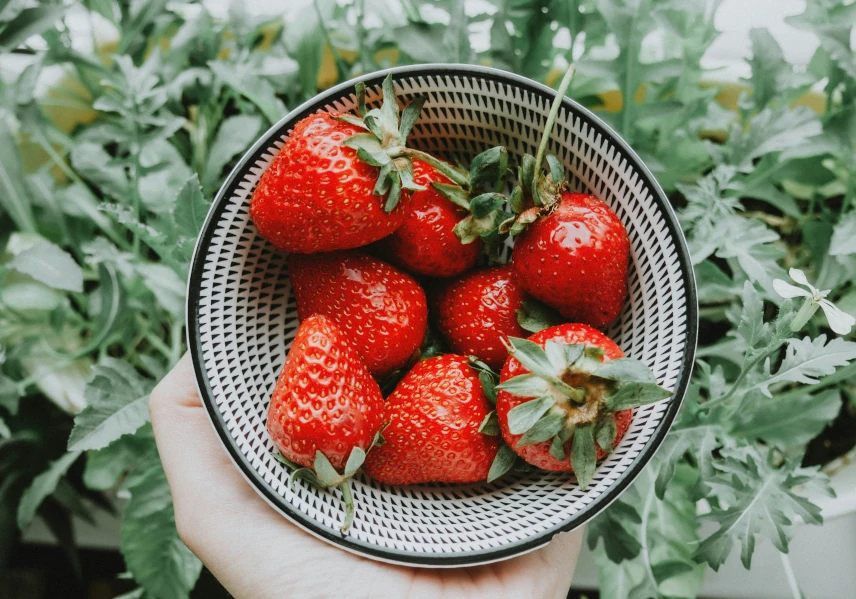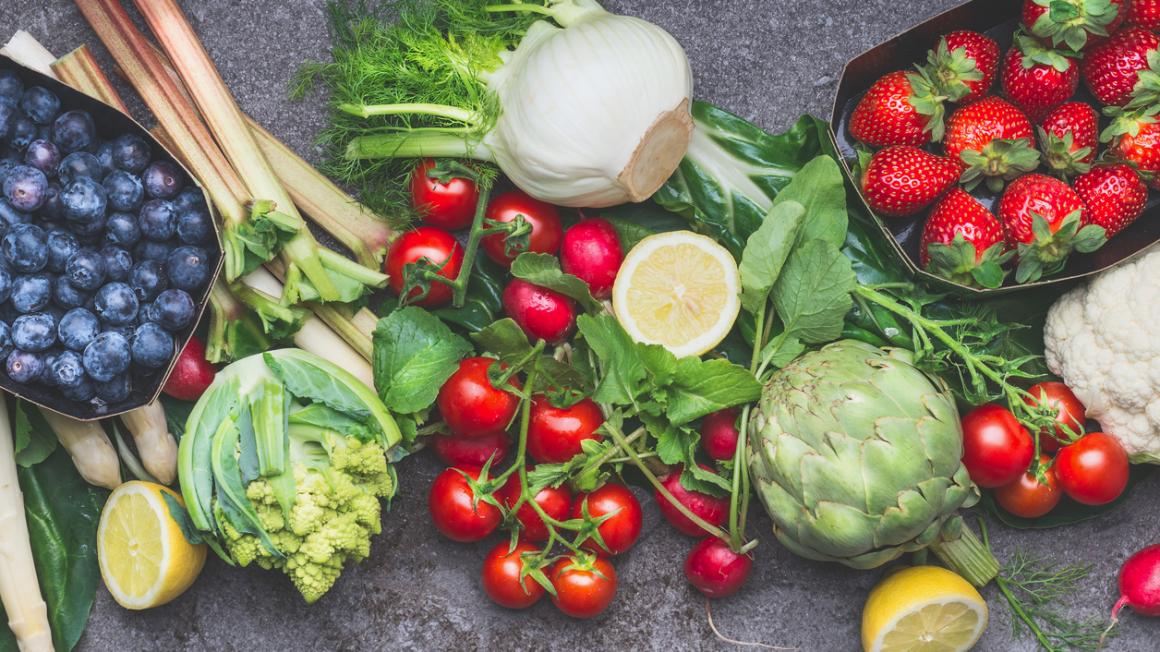In many ways, modern consumers like you and I are spoilt for choice by big-brand supermarkets that can afford to fly in our favourite foods and products year-round so that we don’t have to wait an entire year for those delicious plump strawberries or lovely juicy pineapples. But it’s a bit of a double-edged sword, isn’t it?
We’re so used to having all the foods we want at our fingertips that we often overlook fresher, locally grown seasonal produce in favour of the stuff that gets shipped in from warmer climates, and for what? Convenience?
With sun teasing out all the summer’s best seasonal fruit and veg, there couldn’t be a better time to rediscover eating fresh!

The perks of eating seasonal produce
Now, it’s quite the commitment to completely change your shopping/ eating habits just for the sake of eating in season, so what are the benefits?
Well, for one, research suggests that fruits and veggies that are in season have a higher nutritional value than those which spend a week or so travelling the world to get to you. That’s not just the case in the summer either; even the wintry root veg we put on our roast dinners is better to eat, the fresher it is, so going for locally grown seasonal produce is a great option to boost the quality of our food.
For a more in-depth look on all of the nutrients your body needs and what they do, check out our guide to healthy supplements and superfoods here!
From a financial point of view too, eating in season will often see your cupboards and fridge shelves stocked for longer before the foods start going bad. This, again, ties into the whole eating local conversation. The quicker you can get food to your table – helped by it being seasonally grown by local farmers – the better!
On top of the health benefits of eating fresher, the greener minded among us might be interested by the environmental impact switching to seasonal foods can have. In a basic sense, it all boils down to supply and demand for the supermarkets. If we all switch one or two locally grown products for ones which are flown in year-round, for instance, the carbon footprints made by big brand importers could be cut massively

Summer’s sweetest treats
So, what fruits are best to go for in the summer months? Well, I hope we all like berries, currants, and cherries because boughs and bushes will be filled to the brim with these sweet treats throughout the year’s warmer months. Ripe for the picking from late spring to early autumn, berries and cherries have their heyday between June and September – just make sure to wash them thoroughly before eating!
Elsewhere in the summer sun, you can find an abundance of fruits known as ‘Prunus’ – that basically just means any fruit in the same family as plums, apricots and damsons. These slightly tart, bitesize bundles of goodness are excellent sources of vitamins A, C and K and can be eaten either fresh or dried.
Aside from the sweeter fruits on offer throughout the summer months, there are a few lesser-used options which are get an unfairly bad rap. Rhubarb is just one of those fruits. Even though it flourishes in the hotter months, it remains woefully underused. While the plant’s sour taste when eaten raw can be understandably off-putting, when cooked it really is a delight – and is high in key nutrients too!
Rhubarb is particularly rich in antioxidants which are thought to have anti-bacterial, anti-inflammatory and other health-boosting properties.
Ok, but where do we get started with seasonal fruits? Well, if a slightly different seasonal sweet is something you’d be interested in trying this summer, this recipe is a winner for all those evenings in the sun.

Rhubarb Fool
(Serves 6)
Ingredients:
- 350g rhubarb
- 75g caster Sugar (add more to taste as necessary)
- 1 lemon/ orange (zested and juiced)
- 300ml double cream
- 1 inch of grated ginger root (or one teaspoon ground)
- 1 tsp vanilla extract
Optional:
- 2 cardamom pods
- 1 cinnamon stick
- 25ml Cointreau/ Triple Sec (if it’s a grown-up fool!)
Method:
- First, trim and wash your rhubarb before chopping into roughly inch long pieces.
- Place the rhubarb in a medium pan along with 50g of your sugar, the zest and juice of the lemon, and the grated/ powdered ginger. At this point it’s worth saying, rhubarb goes exceptionally well with all sorts of different sweet spices so this would be where you’d add the cinnamon/cardamom pods/ any other spice that might take your fancy – just be gentle with it!
- Top the rhubarb mixture up with enough water to just about cover it. Bring to the boil and then let simmer until soft. While your fruit is boiling, whip the double cream with the remaining sugar and a teaspoon of vanilla extract until it forms soft peaks. You can add your alcohol here for a boozy kick!
- Once your rhubarb is soft, take it off the heat and remove with a slotted spoon and set aside to cool. Simmer the remaining juices until around half of the liquid has dissolved and your left with a slightly thickened syrup. Allow to cool.
- Preference comes in here: you can either keep the cooked rhubarb whole or gently mash it to give your fool a smoother texture. Whichever you decide, reserve a few vibrant pieces of rhubarb for garnish and add the rest to the cream mixture, folding it in until it is nicely combined. Refrigerate your mixed fool for half an hour.
- Once chilled, decant into your bowls/ glasses of choice and garnish with the reserved rhubarb and a light drizzle of your cooled syrup. Enjoy!

Courgettes to Cauliflower: What Varieties are in Season?
Now, that’s all well and good if you have a sweet tooth, but what about savoury produce? There are a whole range of vegetables ripe for the picking right through the summer and many are so versatile it’d be a mistake not to take advantage of them. While a lot of summer veg is often thought off as salad leaves or BBQ food, there a few great options for warmer dishes for those nights which are just a little too nippy for something cold.
One of the most under utilised of these vegetables is the highly versatile aubergine (or eggplant for our friends across the seas). Aubergines are packed full of Vitamins B1 and B6 which help us maximise the energy we can get out of the food we eat and help us feel fuller for longer. Preparing aubergines is a doddle too; they can be sliced and grilled, chopped into a curry or halved and roasted to really soften up the inner flesh. Whichever cooking method you choose, remember to season your food well and use oil sparingly as aubergines can tend to take on a lot of grease.
Aside from these deliciously underused bits of produce, some household names come into their own throughout the summer months. Cucurbits – like cucumbers, courgettes, and summer squash – are all well in-season from around June until October time and so easy to incorporate into a whole variety of meals.
Having soaked up all that glorious summer sun, for instance, cucumbers are extraordinarily low on calories but are still abundant in antioxidants and vitamins K & C – and no that’s not a KC and the Sunshine Band joke! This makes them excellent options for promoting weight loss and keeping you well-hydrated while giving a bumper load of goodness to keep your body strong and healthy.
Cucumbers don’t have to just be salad food either, there are a whole range of fresh and interesting recipes which can help you really bring the humble cucumber into a world of its own. BBC Good Food, for example, has a great recipe for cucumber soup right here!
So, there you have it. Whether you’re enjoying its bountiful berries or going for a lesser-tried veggie option, there’s no better time to start eating seasonal produce!
To help us make Britain one million biological years younger take our autum Lifescore calculator to determine your biological age and use our autum app on Android or IOS to help improve your biological age today!
Images: Alexandr Podvalny, Maximilian Zahn, Anastasia Zhenina on Unsplash.



